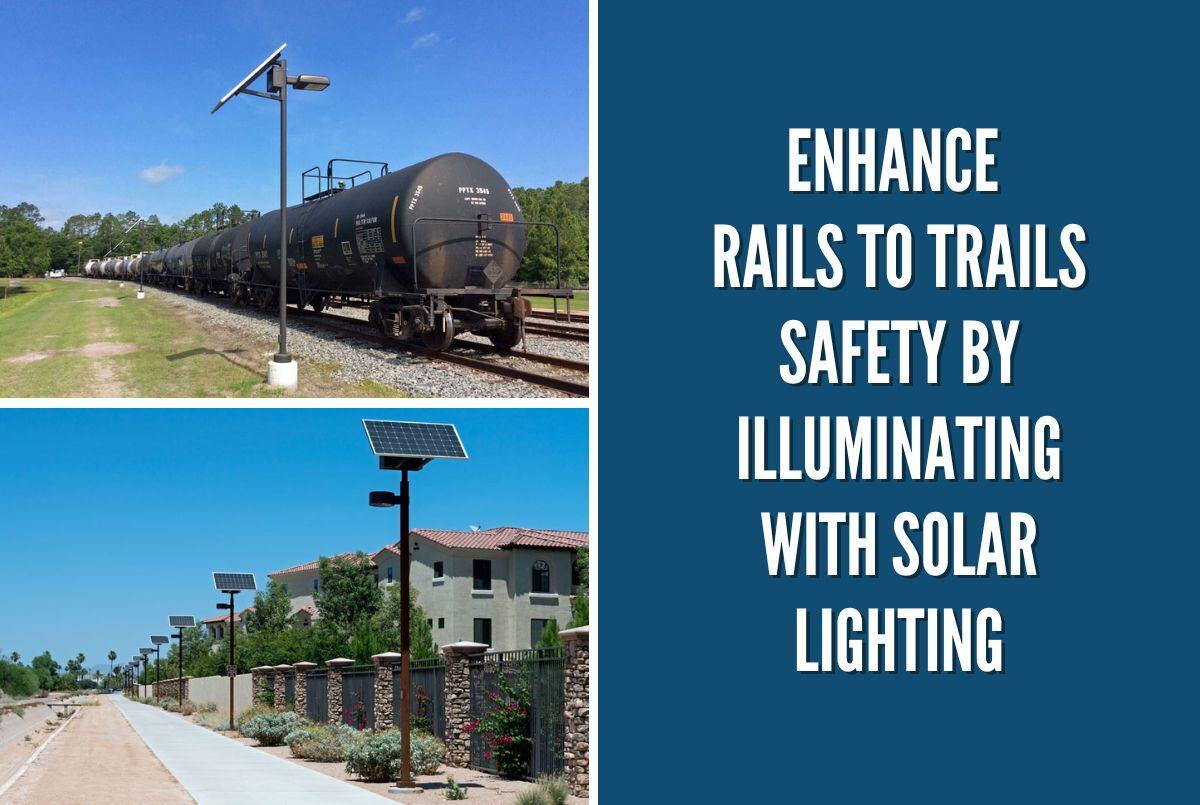Enhance Rails to Trails Safety by Illuminating with Solar Lighting

Contents
Imagine a serene evening stroll along a rail trail, with the gentle glow of solar lights illuminating your path and creating a magical ambiance. The simple addition of solar lighting can truly transform nighttime safety and usability on rail trails, turning them into inviting and secure spaces for all to enjoy after dark.
In this post, we will discuss the importance of lighting on these remote trails, the benefits of using solar lighting to illuminate the trails, how the installation and maintenance would work, and even a case study on how solar lighting has worked for a customer along their trail project. We want to make sure you are well-informed about illuminating your rails-to-trails project with sustainable solar lighting systems.
The Importance of Lighting on Rail Trails
Rail trails are popular recreational spaces that walkers, runners, and cyclists often use during the day. However, these trails can become dark and potentially unsafe when the sun sets. That's where lighting comes in. Adequate lighting on rail trails is essential for ensuring the safety of trail users during nighttime hours. It illuminates the path ahead, helps deter criminal activity, and provides a sense of security for those using the trail after dark.
By installing proper lighting along rail trails, trail users can feel more confident and comfortable using the trail during evening hours. It allows them to see any potential hazards or obstacles in their path, reducing the risk of accidents and injuries. Lighting also encourages more people to use the trail at night, promoting a healthy and active lifestyle for all.
In addition to safety, lighting on rail trails also enhances the overall user experience. It creates a welcoming and inviting atmosphere, making the trail more enjoyable to use. Whether it's for a leisurely stroll, a jog, or a bike ride, having a well-lit trail can make all the difference.
Benefits of Solar Lighting for Trail Safety
When it comes to lighting rail trails, solar lighting is a smart and sustainable choice. Unlike traditional lighting systems that rely on grid electricity, solar lighting harnesses the power of the sun to generate energy. This means that solar lights are completely independent from the electrical grid, making them a cost-effective and environmentally-friendly option.
One of the major benefits of solar lighting for trail safety is its ease of installation. Solar lights can be easily mounted along the trail without the need for extensive wiring or electrical infrastructure. This makes them a flexible solution that can be installed in a variety of locations, including remote areas where trenching in grid power is impractical and cost-prohibitive. Additionally, many commercially designed solar lights are low-maintenance, requiring minimal upkeep and reducing ongoing maintenance costs.
Solar lighting systems also provide reliable illumination throughout the night. With advanced technology and efficient solar panels, these lights store energy during the day in a battery pack and uses the stored energy to power the LED lights at night. This ensures that the trail remains well-lit, even during extended periods of darkness. Some solar lights can also have a built-in sensor that automatically adjusts the brightness depending on the time of night, further optimizing energy usage.
By choosing solar lighting for trail safety, trail managers can demonstrate their commitment to sustainability and environmental stewardship. Solar lights produce zero carbon emissions and have a minimal impact on the surrounding ecosystem. They are a long-term investment that not only benefits trail users but also supports a greener and more sustainable future.
How Solar Lighting Works for Rails-to-Trails Projects
Solar lighting harnesses the sun's power to generate electricity. Each solar light is equipped with a photovoltaic (PV) panel that absorbs sunlight and converts it into usable energy. This energy is then stored in a rechargeable battery within the light fixture. A reliable solar lighting system has plenty of backup to ensure there is plenty of storage for times of inclement weather as well.
When the sun sets, the solar light automatically turns on, using the stored energy to power the LED lights. LED lights are energy-efficient and provide bright and focused illumination along the trail. Some solar lights also have motion sensors, which detect movement and increase the brightness when someone is nearby.
The PV panels on solar lights are designed to capture sunlight from all angles, ensuring maximum energy absorption throughout the day. Even on cloudy or overcast days, solar lights can still generate enough energy to power them at night. This makes them a reliable lighting solution for rail trails in any weather condition.
In addition to their functionality, solar lights are also designed to be durable and weather-resistant. They are built to withstand harsh outdoor conditions, including rain, snow, extreme temperatures, and even high wind events such as hurricanes. This ensures that the lights can continue to operate effectively and efficiently, providing illumination and safety on rail trails for years to come.
Installation and Maintenance of Solar Lights on Trails
Installing solar lights on rails to trails projects is a straightforward process that can be completed with minimal disruption to the trail and its surrounding natural area. Since solar lights are self-contained and do not require any external power source, there is no need for trenching or underground wiring. This reduces the installation time and cost, making solar lighting a practical choice for trail managers.
Installation of the solar lights is quite easy. The solar lighting systems are mounted to a solar light pole designed for the project to ensure it can withstand the system weight and EPA for the local AASHTO wind load requirements. All wiring is contained at the top of the pole. and the solar panel is mounted to a bracket to optimize the amount of sunlight exposure, ensuring optimal energy generation. Once everything is wired up on the pole, the lights are ready to provide illumination and safety on the trail.
Solar lights on rail trails also require minimal maintenance. To maintain optimal performance, the PV panels should be cleaned to remove dust and debris every year or so. Additionally, the rechargeable batteries will need to be replaced after a few years of use to ensure efficient energy storage. Overall, solar lights require much less maintenance than traditional lighting systems, reducing ongoing costs and efforts.
Want to learn more about the Rails to Trails projects? Check out the Rails to Trails Conservancy and see what they are working on. Ready to light up your trail project? You can request a quote online or call us at 800-974-9918 and speak to a solar lighting specialist today who can help you with your project.

